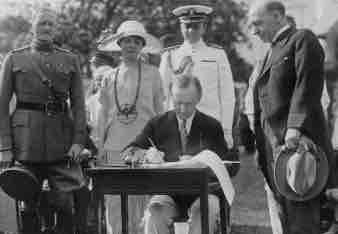The early 20th Century in the United States saw widespread racism targeting immigrants and the emergence of a “nativist” movement demanding favored status for established citizens over new immigrants. Nativism meant opposition to immigration and support for efforts to lower the political or legal status of specific ethnic or cultural groups they considered contrary to American society and unable to assimilate. U.S. nativists wanted to prevent immigration from Southern and Eastern Europe, especially Italy and Poland, due to anti-Catholic sentiment and Nordicism, a racist theory that considered Southern Europeans and Eastern Europeans inferior to people from Scandinavia, Finland and Iceland. Eugenics, a racially based pseudo-science, also fueled anti-immigrant sentiment.
Literacy Tests and Immigration Restrictions
Between 1890 and 1920, nativists and labor unions campaigned for immigration restriction through the implementation of a mandatory literacy test that would bar admission of immigrants who could not read or write. Congress passed literacy test legislation, with proponents such as Massachusetts Senator Henry Cabot Lodge arguing that it could benefit overall immigration policy. Yet in 1897 President Grover Cleveland vetoed the legislation. In his response to Congress, Cleveland stated, “The best reason that could be given for this radical restriction of immigration is the necessity of protecting our population against degeneration and saving our national peace and quiet from imported turbulence and disorder. I cannot believe that we would be protected against these evils by limiting immigration to those who can read and write in any language twenty-five words of our Constitution.”
The debate continued, though, and opponents of a literacy test called for the establishment of an immigration commission to focus on immigration as a whole. The United States Immigration Commission, also known as the Dillingham Commission, was established in 1907 as a bipartisan group tasked with studying immigration and its effects. The commission’s final findings in 1911, however, upheld the concerns of the nativist movement. Twenty years after Cleveland’s veto, a literacy requirement was included in the Immigration Act of 1917.
Racial and Religious Nativism
Following World War I, nativists in the 1920s focused their attention on Catholics, Jews, and southeastern Europeans, realigning their beliefs using racial and religious criteria. The racial concerns of the anti-immigration movement were closely linked to Eugenics, a racial pseudo-science that had taken hold in Europe and was quickly gaining popularity in the United States. Influenced by Madison Grant's 1916 pro-Eugenics book, The Passing of the Great Race, nativists grew increasingly concerned with America’s ethnic purity and what Grant argued was the dilution of the national racial stock by an influx of new immigrants from the Mediterranean, the Balkans and the Polish ghettos. The second Ku Klux Klan flourished in the U.S. by using strong nativist rhetoric filled with this racial bias.

Madison Grant
Madison Grant's book The Passing of the Great Race was a prominent exposition of nativism. It contributed to the anti-immigration movement and consequently, immigration quota legislation in the 1920s.
In the 1920s, a large national consensus fueled by fears of low-skilled immigrants flooding the labor market helped sharply curtail the overall inflow of newcomers accepted to the United States.
Legislation to Restrict Immigration
The widespread acceptance of racist ideology and labor concerns led to a reduction in Southern and Eastern European immigrants being codified in the National Origins Formula of the Emergency Quota Act of 1921, which capped new immigrants at 3% of the number of people in that same ethnic group already in the United States. It also limited immigrants to 357,803 for those arriving outside of the western hemisphere. This was a temporary measure and was followed by a further lowering of the immigrant quota to 2% in the Immigration Act of 1924, which also reduced the number of immigrants to 164,687. During the late 1920s, an average of 270,000 immigrants were allowed to remain, mainly because of the exemption of Canada and Latin American countries.

Signing of the Immigration Act of 1924
President Calvin Coolidge signs the Immigration Act of 1924 on the south lawn of the White House.
Dwindling Immigration Concerns
European-American ethnicities diminished as a political issue in the 1930s. After the Immigration Act of 1924 significantly reduced the intake of non-Nordic ethnicities, the Great Migration of African-Americans out of the South displaced anti-white immigrant racism with anti-black racism. Additionally, the Great Depression raised economics over ethnic purification in the hierarchy of national concerns.